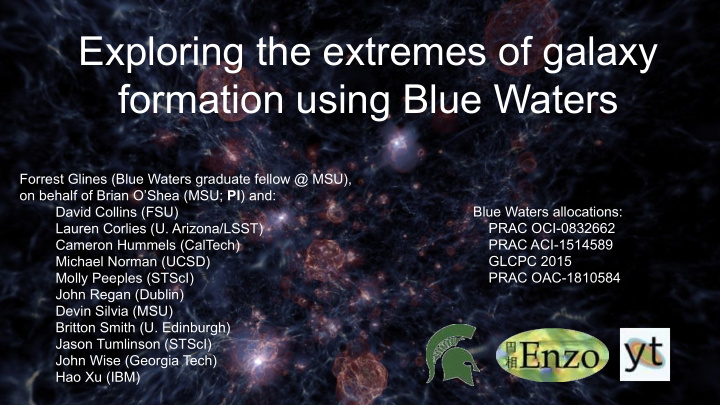



Exploring the extremes of galaxy formation using Blue Waters Forrest Glines (Blue Waters graduate fellow @ MSU), on behalf of Brian O’Shea (MSU; PI ) and: Blue Waters allocations: David Collins (FSU) Lauren Corlies (U. Arizona/LSST) PRAC OCI-0832662 PRAC ACI-1514589 Cameron Hummels (CalTech) Michael Norman (UCSD) GLCPC 2015 PRAC OAC-1810584 Molly Peeples (STScI) John Regan (Dublin) Devin Silvia (MSU) Britton Smith (U. Edinburgh) Jason Tumlinson (STScI) John Wise (Georgia Tech) Hao Xu (IBM)
What has Blue Waters done for our research? 1. Provided a stable, capability-class computational platform for several years with large memory per core, a fast interconnect, and an excellent I/O subsystem. 2. Provided excellent, friendly, and highly capable technical staff throughout our time working with the project. 3. Provided strong support for students, including excellent training and opportunities to present their work to a national audience!
Two key results from our Blue Waters simulation campaigns
A new mechanism for forming supermassive black holes in the early universe Wise et al. 2019, Nature, 566:85-88
NASA/CXC/MIT/Banganaff et al.
M87 black hole, c/o Event Horizon Telescope collaboration
The Renaissance Simulations (O’Shea et al. 2015) Movie c/o Donna Cox, Bob Patterson, NCSA Advanced Visualization Laboratory
The high-resolution circumgalactic medium Peeples et al. 2019 (ApJ, 873, 129; arXiv:1810.06566) Corlies et al. 2019 (ApJ, submitted; arXiv:1811.05060) Hummels et al. 2019 (ApJ, submitted; 1811.12410)
Standard simulation
Forced refinement simulation
Enhanced CGM resolution Standard CGM resolution
Preparing for exascale architectures
K-Athena: a performance portable implementation of Athena++ ● Based on Athena++ (Gardiner & Stone 2009) and the Kokkos performance portability library (github.com/kokkos) ● Experiment: attain excellent GPU performance while maintaining high level of CPU performance! 1.94 trillion cell updates/s On 4,096 nodes of Summit: ● Test problem: double precision MHD linear wave advection test using 16 petaflops sustained performance! standard Athena++ reconstruction and Riemann solver ● Measure CPU, GPU performance, strong and weak scaling Grete, Glines & O’Shea 2019, submitted (arXiv:1905.04341; code publicly available)
Enzo-E: an exascale cosmology code ● Uses Charm++ parallel runtime system for task management, redundancy, etc. ● “Forest of octtree” AMR with fully distributed data structures ● Scalable gravity solvers, modular fluid, chemistry, particle-pusing, etc. solvers ● Development currently underway: ○ MHD ○ Local, causality-preserving time-stepping ○ Fast multipole method gravity solver ○ Performance portability using Kokkos github.com/enzo-project/enzo-e and cello-project.org
Summary ● Blue Waters has provided a powerful platform for exploring some of the most extreme physical phenomena in the universe. ● We have discovered a new mechanism for forming supermassive black holes, in primordial galaxies that grow quickly in radiation-rich environments. ● We have discovered that highly resolving the circumgalactic medium is critical to forming observationally-plausible structures and interpreting observations. ● Our experiences on Blue Waters have given us crucial insights to preparing for exascale supercomputers.
Recommend
More recommend